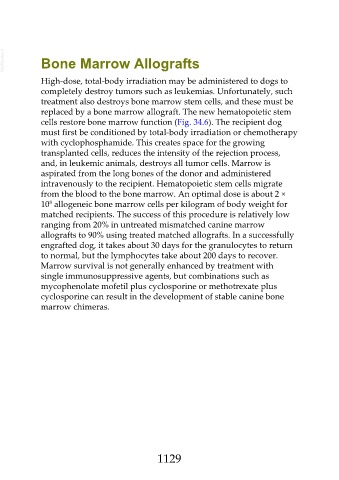Page 1129 - Veterinary Immunology, 10th Edition
P. 1129
VetBooks.ir Bone Marrow Allografts
High-dose, total-body irradiation may be administered to dogs to
completely destroy tumors such as leukemias. Unfortunately, such
treatment also destroys bone marrow stem cells, and these must be
replaced by a bone marrow allograft. The new hematopoietic stem
cells restore bone marrow function (Fig. 34.6). The recipient dog
must first be conditioned by total-body irradiation or chemotherapy
with cyclophosphamide. This creates space for the growing
transplanted cells, reduces the intensity of the rejection process,
and, in leukemic animals, destroys all tumor cells. Marrow is
aspirated from the long bones of the donor and administered
intravenously to the recipient. Hematopoietic stem cells migrate
from the blood to the bone marrow. An optimal dose is about 2 ×
8
10 allogeneic bone marrow cells per kilogram of body weight for
matched recipients. The success of this procedure is relatively low
ranging from 20% in untreated mismatched canine marrow
allografts to 90% using treated matched allografts. In a successfully
engrafted dog, it takes about 30 days for the granulocytes to return
to normal, but the lymphocytes take about 200 days to recover.
Marrow survival is not generally enhanced by treatment with
single immunosuppressive agents, but combinations such as
mycophenolate mofetil plus cyclosporine or methotrexate plus
cyclosporine can result in the development of stable canine bone
marrow chimeras.
1129

